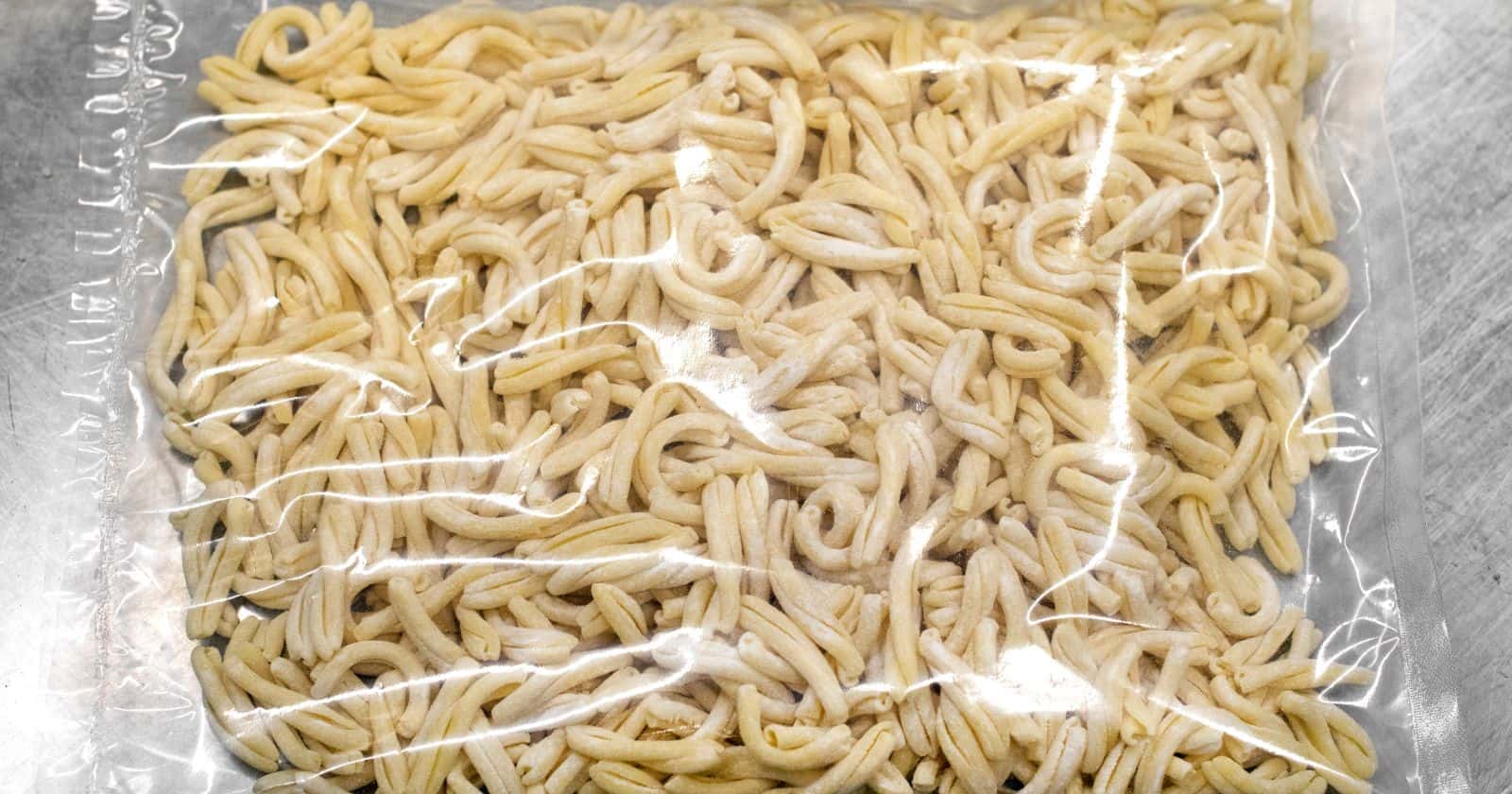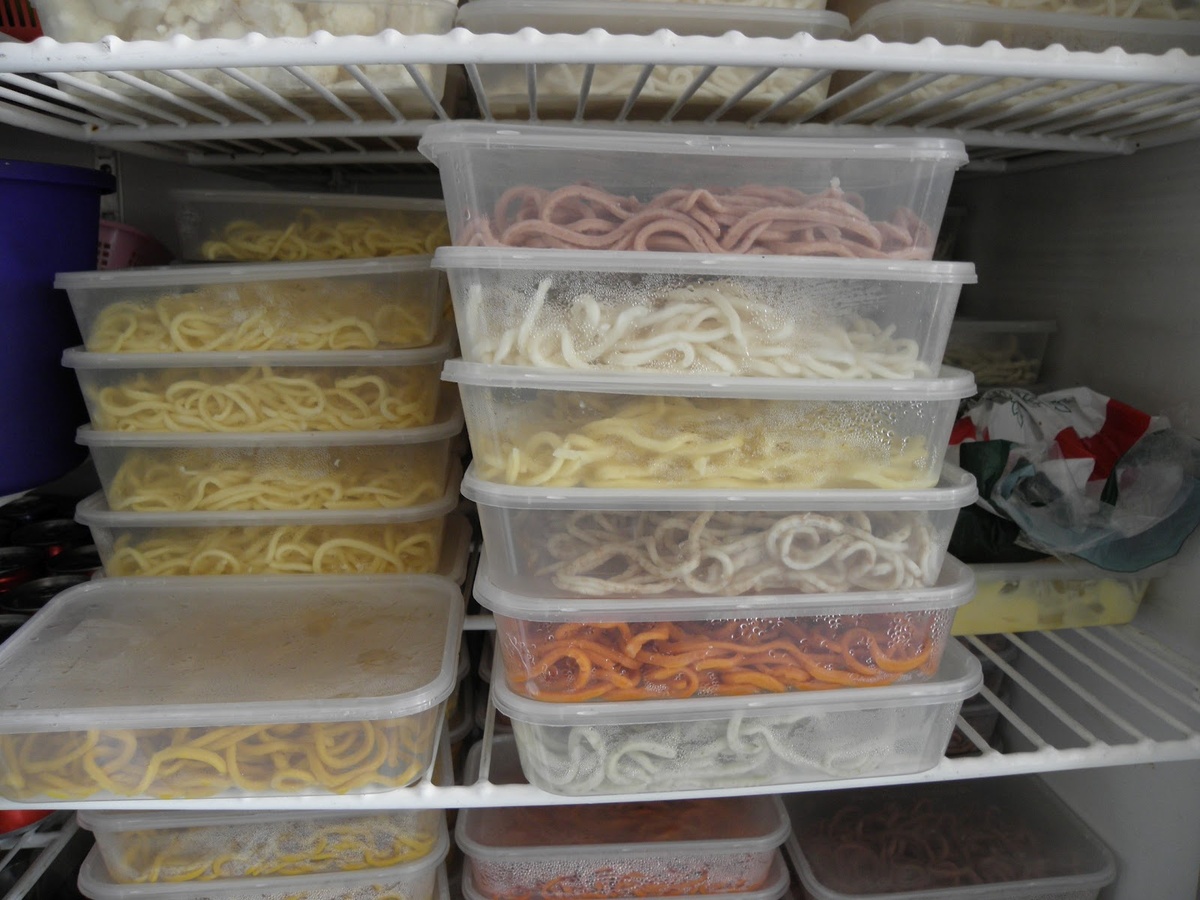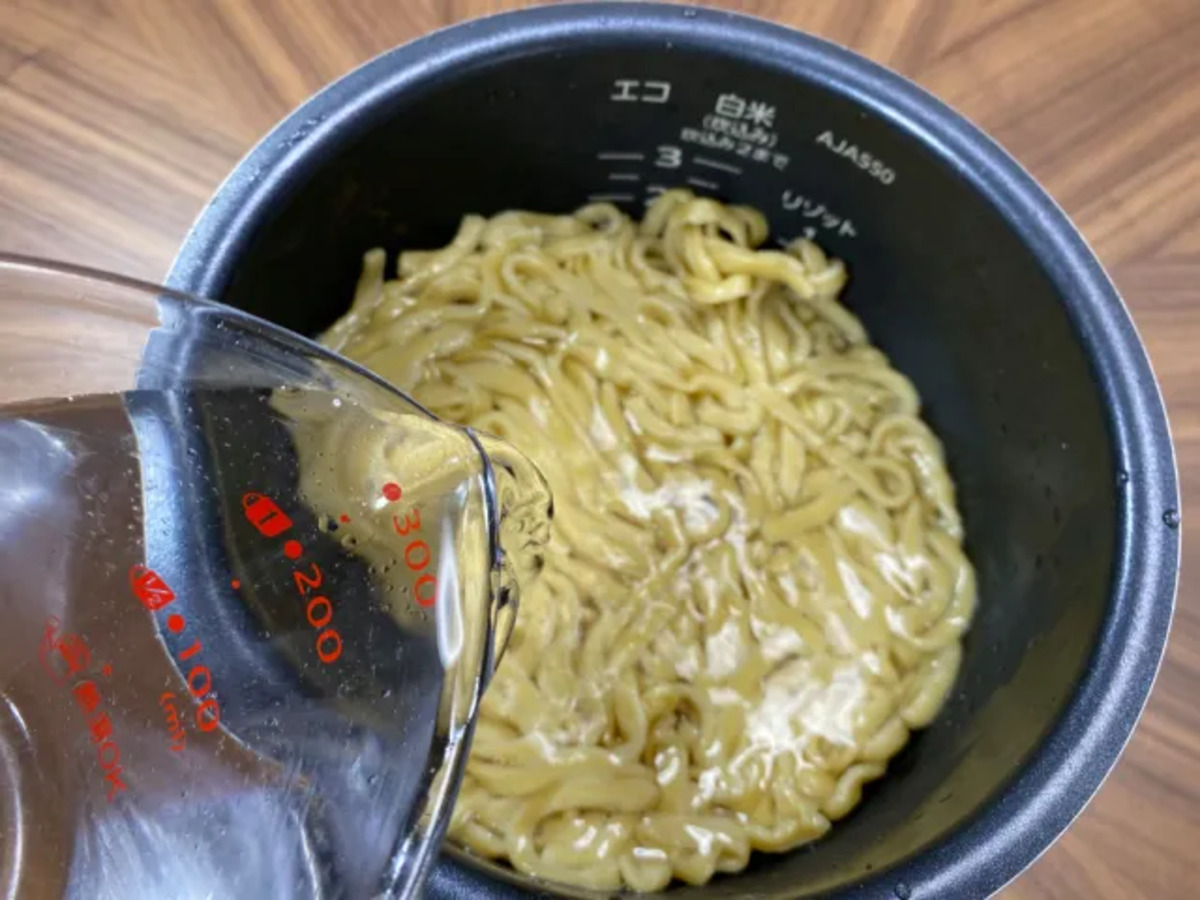

Articles
How To Store Ramen Noodles Long Term
Modified: May 6, 2024
Looking for articles on how to store ramen noodles long term? Discover expert tips and tricks to keep your favorite noodles fresh for an extended period.
(Many of the links in this article redirect to a specific reviewed product. Your purchase of these products through affiliate links helps to generate commission for Storables.com, at no extra cost. Learn more)
Introduction
Ramen noodles have become a staple food for many people around the world. The convenience, affordability, and delicious taste make them a popular choice for quick meals. However, have you ever considered storing ramen noodles long term? Whether you want to stock up for emergencies, save money by buying in bulk, or simply enjoy your favorite noodles whenever you please, knowing how to store ramen noodles long term is essential.
In this article, we will explore the reasons why storing ramen noodles long term can be beneficial. We will also discuss the proper packaging, storage conditions, and methods to ensure the longevity and quality of your stored noodles.
Read more: How To Store Noodles Long Term
Why store ramen noodles long term?
There are several reasons why storing ramen noodles long term makes sense:
- Emergency Preparedness: Disasters can strike unexpectedly, leaving us without access to food. Having a stockpile of long-lasting ramen noodles ensures that you have a convenient and easy-to-prepare meal option during emergencies.
- Cost Savings: Buying ramen noodles in bulk and storing them long term can help you save money in the long run. You can take advantage of discounts and promotions, avoiding price increases in the future.
- Convenience: Having a stash of ramen noodles ensures that you always have a quick and tasty meal option on hand. Whether you’re in a hurry or simply craving a bowl of noodles, you won’t have to make a trip to the grocery store.
Choosing the right packaging
The choice of packaging plays a crucial role in ensuring the longevity and freshness of your stored ramen noodles. Here are some options to consider:
- Mylar Bags: Mylar bags provide an excellent barrier against moisture, light, and oxygen. They are durable and flexible, making them suitable for long-term storage.
- Vacuum-Sealed Bags: Using a vacuum sealer can remove excess air from the packaging, preventing spoilage and preserving the flavor and texture of the noodles.
- Plastic Containers: Opt for food-grade plastic containers with airtight lids. Make sure they are clean, dry, and free from any lingering odors.
By choosing the right packaging, you can protect your ramen noodles from moisture, pests, and other external factors that could compromise their quality.
Key Takeaways:
- Storing ramen noodles long term provides benefits such as emergency preparedness, cost savings, dietary convenience, and everyday meal solutions. Proper packaging and storage conditions are crucial for maintaining freshness and quality.
- Mylar bags, vacuum-sealed bags, plastic containers, and glass jars are suitable packaging options for long-term storage of ramen noodles. Adhering to proper storage conditions and utilizing effective storage methods ensures the noodles remain fresh and flavorful.
Why store ramen noodles long term?
There are several compelling reasons why storing ramen noodles long term can be advantageous:
- Emergency Preparedness: Natural disasters, power outages, and other unforeseen emergencies can disrupt the availability of food. Having a supply of long-lasting ramen noodles ensures that you have a reliable source of sustenance during difficult times. They are lightweight, easy to prepare, and provide a comforting and filling meal when access to fresh ingredients may be limited.
- Cost Savings: Buying ramen noodles in bulk and storing them long term can result in significant cost savings. Retailers often offer discounts when purchasing larger quantities, allowing you to stock up on your favorite noodles at a lower price per pack. Additionally, by avoiding price increases and inflation, you can lock in the cost of your favorite noodles for an extended period.
- Dietary Convenience: For individuals with specific dietary restrictions or preferences, long-term storage of ramen noodles can be a practical solution. While traditional instant ramen noodles often come with seasoning packets that may not suit everyone’s needs, by storing plain noodles, you have the flexibility to customize the flavorings and ingredients based on your dietary requirements. This way, you can enjoy a convenient meal while adhering to your specific nutritional needs.
- Everyday Meal Solution: Storing ramen noodles long term is not limited to emergencies or cost savings. Having a readily available supply of instant noodles offers a quick and easy meal solution for everyday life. Whether you need a speedy lunch during a busy workday or a late-night snack after a long day, having your favorite ramen noodles on hand can satisfy your cravings without the need for extensive meal preparation.
- Convenience: Alongside their affordability, instant ramen noodles offer unmatched convenience. Cooking a packet of ramen noodles only requires boiling water and a few minutes of waiting. This simplicity makes it an ideal option for college students, busy professionals, or anyone looking for a hassle-free meal. Having a long-term supply ensures that you can enjoy this convenience whenever you desire.
Storing ramen noodles long term provides numerous benefits, including emergency preparedness, cost savings, dietary convenience, and everyday meal solutions. By understanding these advantages, you can make an informed decision to stock up on your favorite ramen noodles and ensure that you always have a reliable and convenient food source at your disposal.
Choosing the right packaging
When it comes to storing ramen noodles long term, selecting the appropriate packaging is crucial to maintaining their quality and extending their shelf life. Here are some options to consider:
- Mylar Bags: Mylar bags are a popular choice for long-term food storage. They are made of a durable, flexible material that provides an excellent barrier against moisture, light, and oxygen. This helps prevent spoilage and keeps the ramen noodles fresh for an extended period. Mylar bags also come in various sizes, allowing you to store the noodles in convenient portions.
- Vacuum-Sealed Bags: Vacuum-sealing is another effective method for preserving the freshness of ramen noodles. By using a vacuum sealer, you can remove excess air from the packaging, which helps to prevent oxidation and moisture buildup. Vacuum-sealed bags also help maintain the texture and flavor of the noodles over time.
- Plastic Containers: Food-grade plastic containers with airtight lids are an alternative option for storing ramen noodles. These containers should be clean, dry, and free from any residual odors. They provide protection against moisture and pests, ensuring that the noodles remain in optimal condition. It is essential to choose containers with a secure seal to prevent air and humidity from entering and compromising the quality of the noodles.
- Glass Jars: Glass jars with tight-fitting lids can also be used to store ramen noodles long term. These jars are non-reactive, ensuring that the noodles are not affected by any chemical interactions. It is important to keep the jars away from direct sunlight to prevent UV damage. Note that glass jars may not provide as much protection against moisture as other packaging options, so it is crucial to ensure that the noodles are completely dry before transferring them to the jars.
When choosing the right packaging, consider factors such as durability, protection against moisture and pests, and ease of access. Additionally, labeling the packaging with the date of storage can help you keep track of the shelf life of the noodles.
Remember to store your packaged ramen noodles in a cool, dry place away from direct sunlight and fluctuating temperatures. These conditions will help maintain the quality and taste of the noodles for an extended period.
By selecting the appropriate packaging, you can ensure that your long-term stored ramen noodles remain fresh, flavorful, and ready to enjoy whenever you need a quick and satisfying meal.
Read more: How To Store Ramen Noodles
Proper storage conditions
Proper storage conditions are essential to ensure the longevity and quality of your stored ramen noodles. Follow these guidelines to keep them in optimal condition:
- Temperature: Ramen noodles should be stored in a cool and dry environment. The ideal temperature range is between 50°F (10°C) and 70°F (21°C). Avoid exposing the noodles to extreme temperatures or fluctuations in temperature, as this can affect their texture and flavor.
- Humidity: Moisture is one of the biggest enemies of stored food. To prevent the noodles from becoming soggy or moldy, store them in a dry place with low humidity. Moisture can also cause the packaging to deteriorate, so make sure the packaging is moisture-resistant and properly sealed.
- Light: Exposure to light can lead to the degradation of the noodles’ quality. Store the packaged ramen noodles in a dark or opaque container to protect them from light. If using transparent packaging, place the containers in a dark place or cover them with an insulating material to block out any light.
- Pests: Prevent pests, such as insects or rodents, from accessing your stored ramen noodles. Ensure that the storage area is clean and free from any potential food sources that can attract pests. Use airtight packaging to create a barrier against pests and regularly inspect the storage area for any signs of infestation.
- Rotation: While ramen noodles have a long shelf life, it is still important to practice proper rotation to ensure freshness. Use the “first in, first out” method, where you consume the oldest noodles first and replenish your supply with fresh ones. This helps avoid any potential spoilage or loss of quality.
By adhering to these storage conditions, you can preserve the taste, texture, and nutritional value of your long-term stored ramen noodles. Regularly check the packaging for any signs of damage or deterioration and replace it if necessary.
Remember, the storage conditions play a vital role in maintaining the quality of the noodles, so it is important to find a suitable storage area in your home that meets these requirements. Proper storage conditions will ensure that you have a reliable source of delicious noodles whenever you need them.
Store ramen noodles long term by keeping them in a cool, dry place away from sunlight and moisture. Consider vacuum sealing or using airtight containers to extend their shelf life.
Methods for Storing Ramen Noodles Long Term
There are several effective methods for storing ramen noodles long term to maintain their quality and extend their shelf life. Here are a few methods to consider:
- Package and Store: One of the simplest methods is to package the ramen noodles in the chosen storage containers or packaging mentioned earlier. Ensure that the noodles are completely dry before packaging them to prevent moisture buildup. Seal the containers tightly to create an airtight environment that protects against oxygen and moisture.
- Oxygen Absorbers: Adding oxygen absorbers to the packaging can help prolong the shelf life of the ramen noodles. Oxygen absorbers work by removing the oxygen content inside the packaging, which reduces the chances of oxidation and spoilage. Follow the instructions on the oxygen absorber packaging to determine the appropriate amount to use based on the container size.
- Freeze Drying: Freeze drying is another excellent method for long-term storage of ramen noodles. This process involves freezing the noodles and then subjecting them to low pressure, which causes the ice to sublimate. Freeze-dried noodles are lightweight, have a long shelf life, and retain their flavor and texture. You can find freeze-dried ramen noodles in stores or choose to freeze dry homemade noodles using home freeze-drying machines.
- Canning: Canning is a popular method for preserving a variety of foods, including ramen noodles. Cook the noodles and place them in sterilized canning jars. Fill the jars with boiling water, ensuring that the noodles are fully submerged. Apply the lids and process the jars in a pressure canner according to the manufacturer’s instructions.
- Repurposing Mylar Bags: If you choose to use Mylar bags for packaging, you can repurpose the heat-sealed bags often found in store-bought ramen noodle packs. Transfer the dry noodles into these bags, using a heat-sealer to create an airtight seal. This method requires careful handling to avoid puncturing the bags, but it can be an efficient way to store large quantities of noodles.
Each method has its pros and cons, so consider your specific needs, available resources, and level of convenience when deciding on the storage method that works best for you.
Remember to label the packages with the storage date and always conduct regular inspections to ensure that the stored noodles are in good condition. If you notice any signs of spoilage, such as off colors, strange odors, or unusual texture, discard the noodles immediately.
By utilizing these storage methods, you can ensure that your ramen noodles are well-preserved, allowing you to enjoy them for an extended period.
Conclusion
Knowing how to store ramen noodles long term can provide you with a reliable food source, emergency preparedness, cost savings, and convenience. By following proper storage methods and conditions, you can ensure that your stored ramen noodles remain fresh, flavorful, and ready to enjoy whenever you need them.
It is crucial to choose the right packaging, such as Mylar bags, vacuum-sealed bags, plastic containers, or glass jars, to protect the noodles from moisture, light, and oxygen. Properly sealed packaging creates a barrier against external factors that can compromise the quality of the noodles.
Remember to store the ramen noodles in a cool, dry place away from direct sunlight and fluctuating temperatures. Avoid exposing them to high humidity, as moisture can lead to spoilage and deterioration of the noodles.
Whether you are stockpiling for emergencies, looking to save money, or seeking a convenient meal solution, storing ramen noodles long term allows you to have a readily available food option that is quick and easy to prepare.
Select one of the methods mentioned, such as packaging and storing, adding oxygen absorbers, freeze drying, canning, or repurposing Mylar bags, depending on your preferences and resources.
Regularly rotate your supply to ensure freshness and consume the oldest noodles first. Regularly inspect the packaging for any signs of damage or spoilage, and replace it if necessary.
In conclusion, properly storing ramen noodles long term is a practical and effective way to ensure that you always have a tasty and convenient meal option available. By following the guidelines outlined in this article, you can confidently store and enjoy your ramen noodles for an extended period.
Now that you've got the scoop on keeping ramen noodles fresh for ages, why not broaden your preservation prowess? Dive into our guide on long term storage for other staples, ensuring your pantry remains stocked and ready for any situation. On the flip side, if you're wrestling with clutter, our practical steps for pantry organization will transform your pantry closet from chaotic to clutter-free in no time. Both articles are packed with actionable tips to simplify your life and maximize your space.
Frequently Asked Questions about How To Store Ramen Noodles Long Term
Was this page helpful?
At Storables.com, we guarantee accurate and reliable information. Our content, validated by Expert Board Contributors, is crafted following stringent Editorial Policies. We're committed to providing you with well-researched, expert-backed insights for all your informational needs.















0 thoughts on “How To Store Ramen Noodles Long Term”